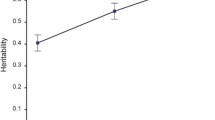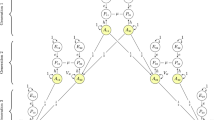Abstract
Several twin studies of multiple abilities and educational and socioeconomic variables suggest that a single common factor underlies the contribution of mate selection and cultural inheritance to the covariation of such measures. Theoretical analysis shows that this finding is consistent with a mechanism of mate selection in which specific abilities are merely components of a composite latent variable for which there is assortative mating. We question how far measures of specific abilities reflect behavioral traits of independent adaptive significance.
Similar content being viewed by others
References
Behrman, J. R., Hrubec, Z., Taubman, P., and Wales, T. J. (1980).Socioeconomic Success. A Study of the Effects of Genetic Endowments, Family Environment and Schooling, North-Holland, New York.
Bock, R. D., and Vandenberg, S. G. (1968). Components of heritable variation in mental test scores. In Vandenberg, S. G. (ed.),Progress in Human Behavior Genetics, Johns Hopkins Press, Baltimore.
Cloninger, C. R. (1980). Interpretation of intrinsic and extrinsic structural relations by path analysis: Theory and applications to assortative mating.Genet. Res. 36:135–145.
Eaves, L. J., and Gale, J. S. (1974). A method for analysing the genetic basis of covariation.Behav. Genet. 4:253–267.
Eaves, L. J., and Heath, A. C. (1981). On the detection of asymmetric assortative mating.Nature 289:205–206.
Edwards, W. (1954). The theory of decision making.Psychol. Bull. 51:380–417.
Fulker, D. W. (1978). Multivariate extensions of a biometrical model of twin data.Twin Research: Psychology and Methodology, Alan R. Liss, New York, pp. 217–236.
Loehlin, J. C., and Vandenberg, S. G. (1968). Genetic and environmental components in the covariation of cognitive abilities: An additive model. In Vandenberg, S. G. (ed.),Progress in Human Behavior Genetics, Johns Hopkins Press, Baltimore.
Martin, N. G., and Eaves, L. J. (1977). The genetical analysis of covariance structure.Heredity 38:79–95.
Martin, N. G., Jardine, R., and Eaves, L. J. (1984). Is there only one set of genes for different abilities? A reanalysis of the National Merit Scholarship Qualifying Test (NMSQT) data.Behav. Genet. 14:355–370.
Plomin, R., and DeFries, J. C. (1979). Multivariate behavioral genetic analysis of twin data on scholastic abilities.Behav. Genet. 9:505–517.
Spearman, C. (1927).The Abilities of Man, Macmillan, London.
Thompson, W. R. (1966). Multivariate experiment in behavior genetics. In Cattell, R. B. (ed.),Handbook of Multivariate Experimental Psychology, Rand McNally, Chicago.
Thurstone, L. L. (1938).Primary Mental Abilities, University of Chicago Press, Chicago.
Author information
Authors and Affiliations
Additional information
This work was supported by grants GM30250 and HL28922 from the National Institutes of Health.
Rights and permissions
About this article
Cite this article
Eaves, L.J., Heath, A.C. & Martin, N.G. A note on the generalized effects of assortative mating. Behav Genet 14, 371–376 (1984). https://doi.org/10.1007/BF01080048
Received:
Accepted:
Issue Date:
DOI: https://doi.org/10.1007/BF01080048




